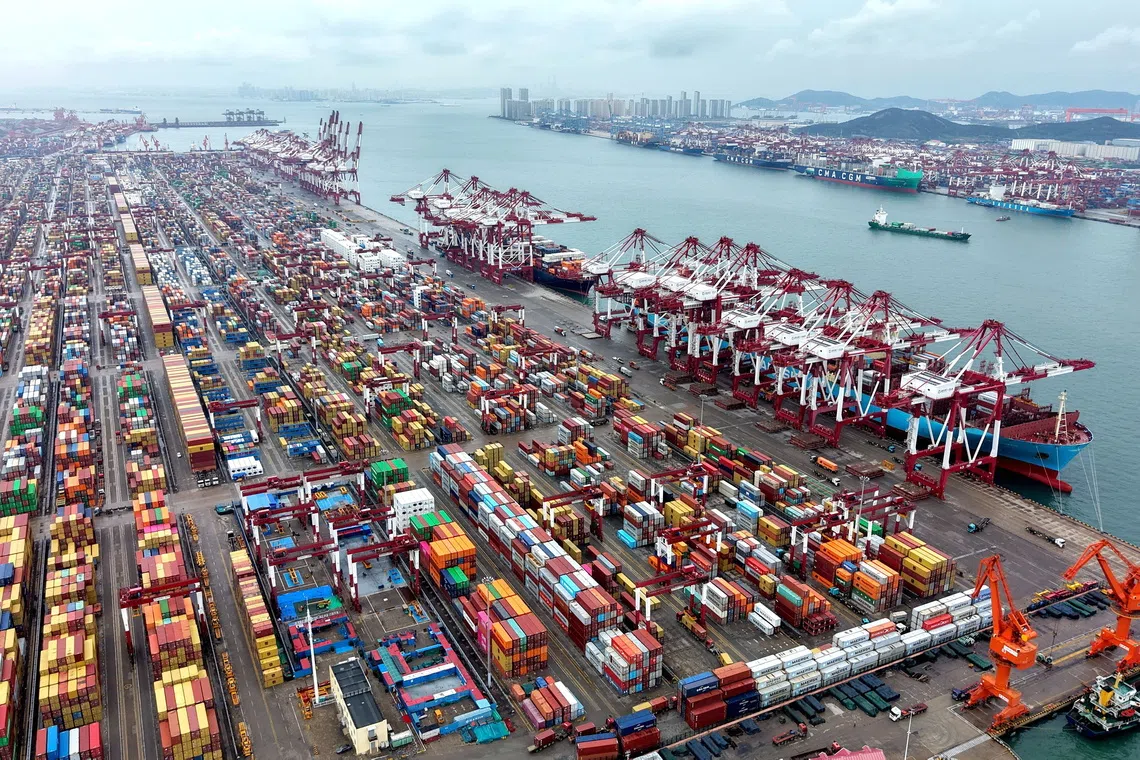US, China roll out tit-for-tat port fees, threatening more turmoil at sea
Sign up now: Get insights on Asia's fast-moving developments

China said it had started to collect the special charges on US-owned, operated, built or flagged vessels but clarified that Chinese-built ships would be exempted.
PHOTO: EPA
Follow topic:
BEIJING/LOS ANGELES – The US and China on Oct 14 began levying port fees on ocean shipping firms that move everything from holiday toys to crude oil, making the high seas a key front in the trade war between the world’s two largest economies.
A return to an all-out trade war appeared imminent last week, after China announced a major expansion of its rare earths export controls
But after the weekend, both sides sought to reassure traders and investors, highlighting cooperation between their negotiating teams and the possibility they could find a way forward.
China said it had started to collect the special charges on US-owned, operated, built or flagged vessels but clarified that Chinese-built ships would be exempted from the levies.
In details published by state broadcaster CCTV, China spelt out specific provisions on exemptions, which also include empty ships entering Chinese shipyards for repair.
The China-imposed port fees would be collected at the first port of entry on a single voyage or for the first five voyages within a year, following an annual billing cycle beginning on April 17.
Early in 2025, the Trump administration announced plans to levy fees on China-linked ships to loosen China’s grip on the global maritime industry and bolster US shipbuilding.
A probe during former US president Joe Biden’s administration concluded that China uses unfair policies and practices to dominate the global maritime, logistics and shipbuilding sectors, clearing the way for those penalties.
China hit back last week, saying it would impose its own port fees on US-linked vessels
Analysts expect China-owned container carrier Cosco to be most affected, shouldering nearly half of that segment’s expected US$3.2 billion (S$4.16 billion) cost from those fees in 2026.
China’s Commerce Ministry on Oct 14 urged the US to “rectify its erroneous practices”, and pursue dialogue and consultation instead.
“If the US chooses confrontation, China will see it through to the end; if it chooses dialogue, China’s door remains open,” it said.
In a related move, Beijing also imposed sanctions on Oct 14 against five US-linked subsidiaries of South Korean shipbuilder Hanwha Ocean, which it said had “assisted and supported” a US probe into Chinese trade practices.
Hanwha said in a message to Reuters it is aware of the announcement and is closely reviewing the potential business impact on the company. Hanwha Ocean’s shares sank nearly 6 per cent.
China also launched an investigation into how the US probe affected its shipping and shipbuilding industries.
Freight fright
“This tit-for-tat symmetry locks both economies into a spiral of maritime taxation that risks distorting global freight flows,” Athens-based Xclusiv Shipbrokers said in a research note.
A Shanghai-based consultant who advises global firms on trade with China said the new fees may not be very disruptive to the industry and any rising costs probably would be captured in higher prices.
“What are we going to do? Stop shipping? Trade is already pretty disrupted with the US, but companies are finding a way,” the consultant said, asking to remain anonymous as he was not authorised to speak with the media.
The US announced on Oct 10 a carve-out for long-term charterers of China-operated vessels carrying US ethane and liquefied petroleum gas (LPG), deferring the port fees for them till the end of Dec 10.
But ship-tracking firm Vortexa identified 45 LPG-carrying VLGCs, or very large gas carriers – 11 per cent of the total fleet – that would still be subject to China’s port fee, its Americas analyst Samantha Hartke said.
Clarksons Research said in a report that the new port fees could affect oil tankers accounting for 15 per cent of global capacity. Jefferies analyst Omar Nokta estimated that 13 per cent of crude tankers and 11 per cent of container ships in the global fleet would be affected.
Retaliation
In a reprisal against China curbing exports of critical minerals, Mr Trump on Oct 10 threatened to slap additional 100 per cent tariffs on goods from China
Trump administration officials hours later warned that countries voting in favour of a plan by the United Nations’ International Maritime Organisation (IMO) to reduce planet-warming greenhouse gas emissions from ocean shipping this week could face sanctions, port bans or punitive vessel charges. China has publicly supported the IMO plan.
“The weaponisation of both trade and environmental policy signals that shipping has moved from being a neutral conduit of global commerce to a direct instrument of statecraft,” Xclusiv said.
Shares in Shanghai-listed Cosco rose more than 2 per cent in early trading on Oct 14.
The company said its board had approved a plan to buy back up to 1.5 billion yuan (S$274 million) worth of its shares within the next three months to maintain corporate value and safeguard shareholder interest.
The shipping firm did not immediately respond to Reuters’ queries about the potential impact of the port fees. REUTERS

